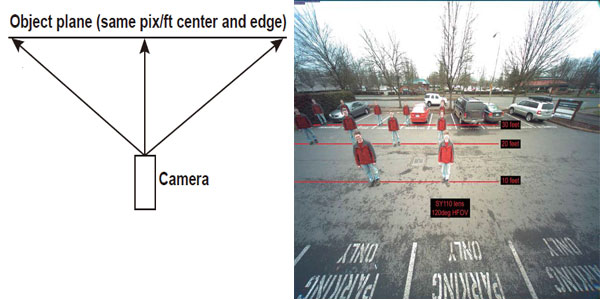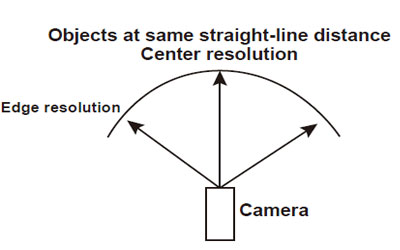Despite inflammatory media accounts proclaiming the end of the megapixel race in the security industry, recent conversations with camera OEMs suggest otherwise. In fact, camera companies appear poised to up the ante and are moving forward with plans to increase camera resolution, following the lead of cellphone and digital camera companies before them.
Despite inflammatory media accounts proclaiming the end of the megapixel race in the security industry, recent conversations with camera OEMs suggest otherwise. In fact, camera companies appear poised to up the ante and are moving forward with plans to increase camera resolution, following the lead of cellphone and digital camera companies before them.
Wide-Angle Lenses
Creating a representation of this world on a two-dimensional plane in a camera creates some optical effects, especially when viewed through a wide-angle lens. There are two approaches used when designing wide-angle lenses: equal angular slices — each pixel receives an equal angle leading to barrel distortion in the image; equal planar distances — each pixel images an equal distance in a plane, this is a rectilinear lens. The two families of wide-angle lenses create very different views of the world.
HD and megapixel cameras have many advantages as long as you have the right lens for the job. When that includes covering large areas or reducing cost by installing fewer cameras, that lens is a wide-angle lens.
includes covering large areas or reducing cost by installing fewer cameras, that lens is a wide-angle lens.
Wide-angle lenses are not a panacea, but there are many applications that benefit from their use. For applications requiring large areas of coverage, an ultra wide-angle lens on a megapixel camera is a cost-saving opportunity that should be considered. Wide-angle lenses can reduce the number of cameras required to cover an area, reducing cost of installation, maintenance and monitoring. They can be used in place of a PTZ camera when post-incident digital PTZ is desired and effectively monitor large areas like parking lots, schools, and construction sites. Also, they can be used in close-up applications such as ATMs, card-locked garage entries, and multi-door entryways where both high image detail and wide field of view (FOV) are required.
Wide-Angle FOV
Another advantage of the higher resolution available from megapixel cameras is the ability to cover a much wider area with the same or better resolution compared to analog cameras. Because the total available pixels spread across the FOV is greater, the FOV can be increased without decreasing image resolution.

Table 1 above compares the FOV of different cameras at a distance of 32 feet from the subject at the same image resolution. As the camera resolution (total number of pixels) increases, so does the field of view at constant image resolution (pixels per foot). Clearly, the higher the number of pixels in the camera, the wider the FOV at a constant image resolution. This increase in FOV is also shown in Figure 1 below.
Rectilinear vs. Fisheye
The shorter the lens focal length, the wider the FOV. When greater than about 90 degrees, most lenses start to show curved, barrel-distorted images that are compressed at the edges. Rectilinear lenses do not exhibit barrel distortion and thus maintain image resolution out to the edge of the image. Traditional wide-angle lenses with barrel distortion (also known as fisheye distortion) cause the image to look curved and bulged out in the center.
Rectilinear lenses keep lines that appear straight in the real world straight on the image sensor. This has the benefit of increasing the resolution of the image at the edges , whereas lenses with barrel distortion cause the image to be compressed at the edges and resolution is reduced.
With typical distorted wide-angle lenses, potentially valuable information is lost in the lens and no software can recapture or reconstruct this lost information in the image. Any dewarping will create an image that looks like that from a rectilinear lens but at lower resolution.
With a rectilinear lens, the image is spread over a greater number of pixels at the edges, increasing the probability of detection and identification.
Objects in a Plane
With a rectilinear lens, objects in a common plane perpendicular to the camera have the same image resolution at the center and edge, even though the objects at the edges are much farther away from the camera. Shown in figure 2 and 3.

Figure 2 Figure 3
For rectilinear lenses, the wider the FOV, the more this effect is noticeable. Rectilinear lenses possess an additional benefit in providing increased resolution at the edges of the image because of 3D stretching. This effect is not what most people are used to seeing but it has the advantage of increased resolution (pixels per foot) for objects at the edge of the image compared to lenses with barrel distortion. For lenses with barrel distortion, the objects at the edge of the image will be smaller than those in the center and they will curve towards the center. Because the effect is only present when objects have length parallel to the camera in the third (depth) dimension, such as the length of the cars, it is called 3D stretching.
Objects in an Arc
With a rectilinear lens, the calculation of resolution of objects in an arc with the camera at the center is a little more complicated. As an object moves from the center of the image towards the edge in an arc without changing the distance to the camera, the object will increase in resolution significantly.

This case, clearly shows the resolution increase as objects move around the arc at constant distance from the camera. The image of the person standing 11.5 feet from the camera will increase in width due to 3D stretching as they move to the edge of the image. At the image edge, they may be more clearly identified compared to the center and compared to a lens with barrel distortion. Lenses with barrel distortion will not show an increase in object width.
Resolution Performance of Lenses based on Linear Optical Technology
Image resolution and horizontal field of view are functions of camera distance for Theia's rectilinear lenses. For example, if 20 pixels per foot are required for a general surveillance application with a 5-megapixel camera and Theia's lens, the camera would need to be 37 feet away from an object in the center of the image.
As the object moves perpendicular to the camera, the image resolution will remain 20 pixels per foot even though the object is getting farther from the camera. The resolution of wide-angle, non-rectilinear lenses will decrease as the object moves along this line.
In summary, there are many definitions of resolution. The two most commonly used in the security industry are total number of pixels in a camera and the pixels per foot in an image. As the total number of pixels increases, the detail in the image or the field of view, or both, can be increased. For wide-angle lenses, rectilinear lenses increase the image resolution at the edges of the image, improving the possibility of detection and identification. High-definition and megapixel cameras need high-performance, wide-angle lenses that can display high-resolution images of large areas. Fisheye lenses create barrel-distorted, curved images requiring software image correction whereas rectilinear lenses correct distortion optically in the lens — an elegant and efficient solution.